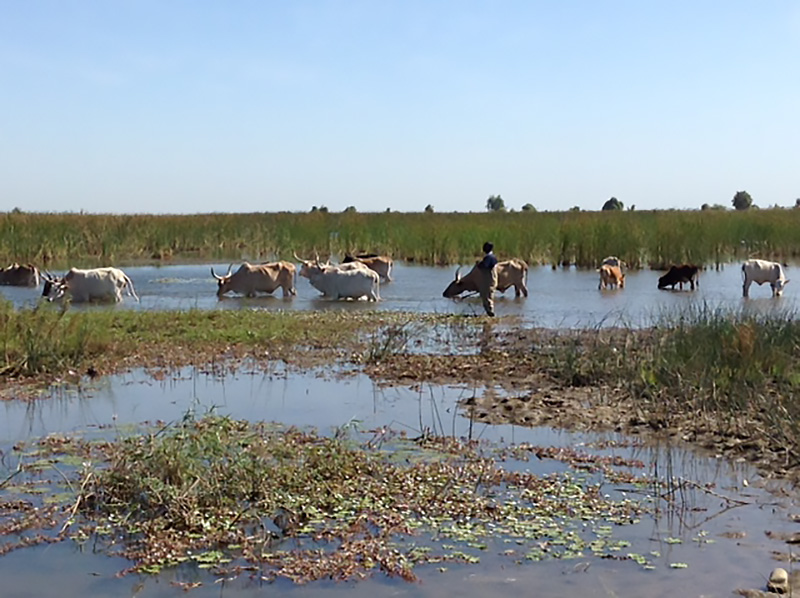Researchers reveal disease mechanism of the bovine TB pathogen
A multidisciplinary team led by researchers from The Francis Crick Institute and including University College Dublin, Public Health England, The Animal and Plant Health Agency and the Royal Veterinary College (RVC) has shed new light on how the bacteria that cause tuberculosis (TB) in humans and animals manipulate the host immune system to cause disease.
The work, published in leading scientific journal PLoS Pathogens, paves the way for a greater understanding of how pathogens ‘jump’ the species barrier and adapt to new hosts.
TB is a devasting disease in humans and animals. Human TB, caused by Mycobacterium tuberculosis, kills more than 1.4 million people a year. The animal TB pathogen Mycobacterium bovis is a threat to the health and welfare of domesticated and wild animals. For example, 40,000 cattle were slaughtered in 2019 as a result of testing positive for bovine TB in Great Britain, with annual costs per year for the control programme over £120 million. Additionally, there are numerous reports from European countries showing that badgers, boars, deer and other wild animals can not only be infected with M. bovis, but are also able to spread it to grazing livestock.
M. bovis is also a risk to human health due to the transmission of infection from animals, especially in societies with a closer animal-human interaction or in immunosuppressed humans. However, it is still unknown how M. tuberculosis and M. bovis have evolved to adapt to their respective human and animal hosts.

Supported through a variety of funders including BBSRC (ERADbTB - Eradication of bovine tuberculosis through basic research and discovery scheme), MRC, Wellcome Trust, Cancer Research UK, Science Foundation Ireland, the Francis Crick Institute, and the RVC, over the last three years, the researchers studied how the bovine and human pathogens interact with cells of the immune system, namely macrophages. They discovered that only the infection of bovine macrophages with M. bovis resulted in the formation of multinucleated giant cells (MNGCs), a hallmark of tuberculous pathology. They went on to identify a specific protein of M. bovis, MPB70, and extracellular vesicles from bovine macrophages as mediators of MNGC formation.
The findings implicate multinucleated giant cell formation in the contrasting pathology between human and bovine bacilli in cattle. The study also reveals how a combination of bacterial factors and species-specific immune responses shapes the unique interaction of the pathogen with its host.
The work has powerful implications for our understanding of how pathogens ‘jump’ the species barrier and adapt to new hosts, highlighting the power of ‘One Health’ approaches that employ comparative studies of human and animal pathogens to decipher disease mechanisms.
Dr Max Gutierrez, Senior Group leader at The Crick Institute and main principal investigator of the work, states that:
“This work opens up new insights into how the pathogens that cause TB in humans and animals have adapted to their hosts.”
Dr Christophe Queval, the lead author of the publication, states that:
“We show how one factor produced by the bovine bacilli helps to catalyse the formation of these giant cells from bovine macrophages.”
Professor Stephen Gordon (University College Dublin), says that:
“We have used a One Health approach to compare the human and animal TB pathogens, shedding new light on how these pathogen causes disease and opening new hope for ultimate control of TB in both humans and animals.”
Dr Javier Salguero, from the Animal and Plant Health Agency, says:
“We reveal that the bacterium that causes TB in cattle, Mycobacterium bovis, interacts with bovine macrophages in a distinct way to human macrophages.”
Professor Dirk Werling, Professor of Molecular Immunology at the RVC, explains that:
“This species-specific interaction drives particular immune cells, macrophages, to become multinucleated giant cells which are a hallmark of TB pathology.”
For more information about the work of Prof Werling's group see RVC Molecular Immunology Lab
Research Reference
Queval CJ, Fearns A, Botella L, Smyth A, Schnettger L, Mitermite M, et al. (2021) Macrophage-specific responses to human- and animal-adapted tubercle bacilli reveal pathogen and host factors driving multinucleated cell formation. PLoS Pathog 17(3): e1009410. https://doi.org/10.1371/journal.ppat.1009410 https://doi.org/10.1371/journal.ppat.1009410
Notes to Editors
For more information please contact:
- Jasmin De Vivo (Jasmin.DeVivo@plmr.co.uk or rvc@plmr.co.uk
- Press Line: 0800 368 9520
About the RVC
- The Royal Veterinary College (RVC) is the UK's largest and longest established independent veterinary school and is a Member Institution of the University of London. It was the first in the world to hold full accreditation from AVMA, EAEVE, RCVS and AVBC.
- The RVC is the top veterinary school in the world according to the QS World University Rankings by subject, 2021.
- The RVC offers undergraduate and postgraduate programmes in veterinary medicine, veterinary nursing and biological sciences.
- In 2017, the RVC received a Gold award from the Teaching Excellence Framework (TEF) – the highest rating a university can receive.
- A research led institution with 79% of its research rated as internationally excellent or world class in the Research Excellence Framework 2014.
- The RVC provides animal owners and the veterinary profession with access to expert veterinary care and advice through its teaching hospitals and first opinion practices in London and Hertfordshire.
